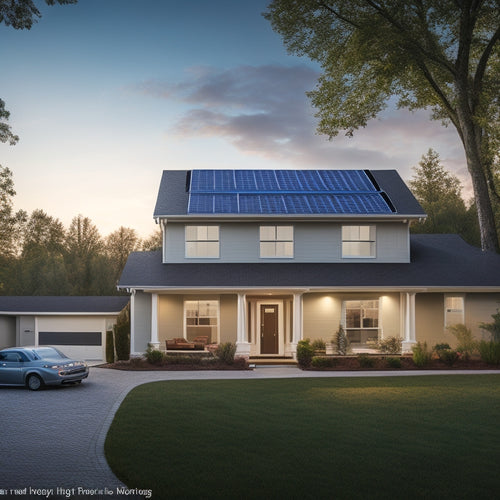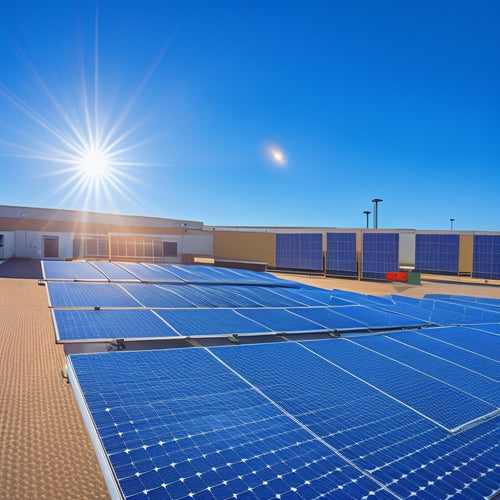
Solar Panel Racking System
Share
When designing a solar panel racking system, you need to optimize panel placement, orientation, and angle to maximize energy yield, reduce system cost, and guarantee long-term durability, all while considering your roof's unique characteristics and potential obstructions. You'll want to assess your roof's dimensions, slope, and orientation to determine the ideal panel layout and angle for maximum sunlight exposure. By evaluating panel types, row spacing, and obstructions, you can increase energy harvest and reduce costs. With the right design, you can access your roof's full solar potential - and there's even more to investigate to get the most out of your system.
The Essentials
- Maximize roof space efficiency by optimizing panel placement, orientation, and row spacing to enhance energy yield and reduce system cost.
- Ensure structural integrity and durability with anodized aluminum frames that provide excellent corrosion resistance and undergo rigorous performance testing.
- Optimize panel angle and orientation to maximize sunlight capture, with ideal angles ranging from 30-40 degrees and south-facing direction typically ideal in the northern hemisphere.
- Implement maintenance considerations, such as regular performance monitoring, to inform maintenance decisions and vary based on roof angle and installation type.
- Ensure safe and secure installation with a strong clamp force distribution system that secures panels tightly in place and prevents micro-cracking or shattering.
Maximize Roof Space Efficiency
When designing a solar panel racking system, you'll want to optimize panel placement to maximize roof space efficiency. By strategically arranging panels, you can increase energy yield and reduce the overall system cost.
To achieve this, you'll need to evaluate factors such as panel orientation, row spacing, and obstructions. A high-quality solar panel mounting system can also help distribute weight evenly to minimize stress and maximize energy output, ensuring proper panel alignment and reducing maintenance costs.
Optimize Panel Placement
Enhancing panel placement is crucial to maximize roof space efficiency, as it directly affects the overall energy output of your solar panel system. A well-planned panel layout guarantees that each panel is installed at the ideal angle and orientation to capture maximum sunlight.
With professional panel installations, you can utilize renewable energy and guarantee a sustainable future Professional Panel Installations.
You'll want to conduct a shading analysis to identify areas where trees, buildings, or other obstructions might cast a shadow on your panels. This analysis will help you determine the best layout to minimize energy losses due to shading.
When designing your panel layout, consider the roof's dimensions, slope, and orientation. You'll need to ascertain that the panels fit snugly within the available space, while leaving sufficient clearance for maintenance and ventilation.
A well-optimized panel layout won't only enhance energy production but also reduce the risk of panel damage or failure. By taking the time to carefully plan your panel placement, you can maximize your roof space efficiency and enjoy a higher return on investment from your solar panel system.
Increase Energy Yield
By carefully designing your panel layout, you've laid the groundwork for maximizing roof space efficiency. Now, it's time to focus on increasing energy yield. This is where installation techniques, maintenance practices, and cost efficiency come into play.
A well-designed racking system guarantees ideal energy conversion by minimizing shading impact and maximizing module efficiency. During the site assessment, consider the structural integrity of your roof to guarantee a secure and compliant installation that meets regulatory requirements.
Furthermore, a reliable Solar Energy Storage solution can alleviate the burden of high energy bills and reduce grid dependence, providing greater energy independence and potential cost savings.
To further enhance energy yield, implement regular performance monitoring to identify areas for improvement. This data-driven approach enables you to make informed decisions about maintenance and upgrades, guaranteeing your system operates at peak efficiency.
By optimizing your solar panel racking system, you'll generate more power while reducing costs. This not only increases your energy independence but also enhances your return on investment.
Increased Energy Harvest
You want to maximize your roof space, and that's where an optimized solar panel racking system comes in.
By maximizing roof space, you'll be able to fit more panels, which directly translates to increased energy harvest.
Additionally, using solar panel brackets and racking systems can help guarantee a secure and efficient installation.
Optimizing the panel angle is also vital, as it guarantees that your panels are positioned to capture the most sunlight possible, moreover enhancing your energy output.
Maximize Roof Space
Across your rooftop, a wealth of untapped energy awaits utilizing, and a well-designed solar panel racking system can release its full potential.
To maximize roof space, you'll want to evaluate the type of solar panels you're using and the installation techniques employed. Different solar panel types have varying efficiencies and sizes, which impact the overall energy production. For instance, monocrystalline panels are more efficient but larger than polycrystalline panels. A well-designed racking system takes these factors into account, ensuring the most energy is harvested from your available roof space.
You'll also want to assess the layout and configuration of your panels. A skilled installer will evaluate your roof's unique characteristics, such as obstructions, vents, and skylights, to optimize panel placement.
This might involve using specialized installation techniques, like bifacial panels or dual-tilt systems, to squeeze the most energy out of your roof. By carefully selecting the right solar panel types and installation techniques, you can maximize your roof space and access the full potential of your solar panel racking system.
Optimize Panel Angle
Maximizing roof space is only half the battle; the next step is to enhance panel angle for increased energy harvest.
You'll want to position your solar panels at an angle that allows them to capture the most sunlight possible. The ideal angle varies depending on your location, but a general rule of thumb is to tilt your panels at an angle equal to your latitude. For example, if you live at a latitude of 35°, your panels should be tilted at 35°.
To achieve the best angle, you can use a panel tracking system that adjusts the tilt of your panels throughout the day. This guarantees that your panels are always facing the sun, resulting in maximum energy production.
Another option is to install a tilt adjustment mechanism that allows you to manually adjust the angle of your panels seasonally. By enhancing your panel angle, you can increase your energy harvest by up to 45%.
This is especially important if you have limited roof space, as every extra watt of energy counts.
Anodized Aluminum Frame Durability
You're likely aware that anodized aluminum frames are a popular choice for solar panel racking systems, and for good reason.
When you specify an anodized aluminum frame, you're getting a material that offers excellent corrosion resistance benefits, which is critical for installations exposed to harsh environmental conditions.
In fact, reliable energy storage solutions, such as off grid solar system, also require durable components to guarantee continuous power supply.
Corrosion Resistance Benefits
When installing a solar panel racking system, it's crucial to take into account the long-term durability of the frame, particularly in harsh environmental conditions. You want to guarantee that your system can withstand the elements and continue to perform at its best for years to come.
This is where corrosion resistance benefits come into play. An anodized aluminum frame provides exceptional corrosion prevention, which means you'll require less maintenance and replacement over time. By choosing a system with a durable frame, you're investing in a hassle-free and cost-effective solution for your renewable energy needs.
Incorporating anodized aluminum frames into your solar panel racking system means you can enjoy a reduced need for maintenance practices. With a corrosion-resistant frame, you won't have to worry about rust or decay compromising the integrity of your system.
This allows you to focus on generating clean energy and enjoying the freedom that comes with it. By prioritizing corrosion resistance, you're guaranteeing a longer lifespan for your system and a reduced environmental impact.
Weathering Performance Testing
Anodized aluminum frames undergo rigorous weathering performance testing to verify their durability in harsh environmental conditions. You want to confirm that your solar panels can withstand the elements, and that's why this testing is vital.
Weathering performance testing evaluates the frames' resistance to corrosion, fading, and cracking, among other weathering effects. This testing simulates real-world conditions, including exposure to UV radiation, saltwater, and extreme temperatures.
During testing, performance metrics such as color retention, gloss retention, and corrosion resistance are measured. These metrics provide an extensive understanding of the frames' durability and ability to maintain their structural integrity over time.
By subjecting the frames to accelerated weathering conditions, manufacturers can identify potential weaknesses and make improvements to the design and materials used.
As a result, you can have confidence that your solar panel racking system will perform effectively, even in the most challenging environmental conditions.
Assess Your Roof's Orientation
You'll want to assess your roof's orientation to guarantee optimal energy harvesting.
The roof angle matters, as a slope that's too shallow or too steep can compromise energy output.
When considering off-grid energy solutions, it's crucial to evaluate your roof's orientation in conjunction with your location's solar irradiance.
Ideally, your solar panels should face directly towards the equator, with a slight tilt to match your latitude, to maximize energy production.
Roof Angle Matters
Maximizing your solar panel racking system begins with analyzing your roof's orientation, as it greatly impacts energy production. The roof angle affects the amount of sunlight your solar panels receive, which in turn affects the energy output. You'll want to verify your solar panels are installed at an ideal angle to maximize energy production.
| Roof Angle | Energy Production | Installation Technique |
|---|---|---|
| 30-40° | Ideal | Standard installation with no additional hardware |
| 10-20° | Good | Installation with adjustable tilt legs for added flexibility |
| 0-10° | Poor | Custom installation with specialized hardware and maintenance considerations |
When evaluating your roof's orientation, consider the installation techniques required to achieve ideal energy production. For instance, roofs with a shallow angle may require adjustable tilt legs to confirm the solar panels receive sufficient sunlight. In contrast, roofs with a steeper angle can use standard installation techniques. Additionally, maintenance considerations come into play, as solar panels installed at a shallow angle may require more frequent cleaning to verify ideal energy production. By analyzing your roof's orientation, you can confirm a solar panel racking system that provides maximum energy output and freedom from energy dependence.
Ideal Direction Facing
During the solar panel installation process, it's essential to assess your roof's orientation to determine the ideal direction facing for maximum energy production.
As you evaluate your roof's orientation, consider the direction that receives the most sunlight exposure throughout the day. In the northern hemisphere, a south-facing direction is generally ideal, as it receives direct sunlight for most of the day. However, this may vary depending on your location and the surrounding environment.
You should also consider shading effects, which can greatly impact energy production. Obstacles such as trees, buildings, or chimneys can cast shadows on your solar panels, reducing their efficiency.
Assess your roof's surroundings to identify potential shading issues and adjust the direction of your solar panels accordingly.
Clamps Secure Panels Tightly
You'll want to guarantee that your clamps distribute force evenly across the solar panels to prevent damage and guarantee a secure fit.
Clamp force distribution is critical, as uneven pressure can lead to micro-cracking or even shattering of the panels.
Clamp Force Distribution
Most solar panel installations rely on a strong clamp force distribution system to secure panels tightly in place. As you design and install your solar panel racking system, it's essential to take into account the clamp force distribution to guarantee your panels can withstand various environmental conditions.
A well-engineered clamp force distribution system guarantees that the clamping force is evenly distributed across the panel, preventing damage or dislodging.
You should focus on optimizing clamp design to achieve a uniform force distribution. This involves conducting a thorough load analysis to determine the maximum expected loads on your solar panels.
By analyzing factors such as wind, snow, and seismic loads, you can design a clamp force distribution system that provides the necessary holding power to keep your panels securely in place.
A sturdy clamp force distribution system not only guarantees the safety and integrity of your solar panels but also helps to maintain their efficiency and performance over time.
Frequently Asked Questions
Can Solar Panel Racking Systems Be Installed on Metal Roofs?
You can install solar panels on metal roofs using specialized mounting options and precise installation techniques, ensuring a secure and efficient energy harvest while maintaining your roof's integrity and flexibility.
Are There Specific Racking Systems for Commercial Solar Installations?
As you venture into the world of commercial solar installations, you'll uncover a setting of customized solutions, where specific racking systems, crafted from durable materials, await, offering precise installation techniques to optimize energy harvest and guarantee a seamless, freedom-filled future.
Do Racking Systems Come With a Warranty or Guarantee?
You'll find that many manufacturers offer warranties or guarantees for their products, typically ranging from 10 to 25 years, contingent upon adherence to installation guidelines, providing you with peace of mind and protection for your investment.
How Do Racking Systems Handle Extreme Weather Conditions?
When Mother Nature releases her fury, you're probably wondering how racking systems withstand the force. Rest assured, they're designed to resist extreme winds and heavy snow loads, ensuring your investment remains secure and functional, come what may.
Can I Install a Solar Panel Racking System Myself?
You can attempt a DIY installation, but be aware that it requires precision and knowledge; make certain you have the necessary skills and follow manufacturer instructions for assembling racking materials to avoid compromising the system's integrity.
Final Thoughts
As you utilize the power of the sun, think of your solar panel racking system as the conductor of an orchestra, expertly positioning each panel to maximize energy production. By optimizing roof space efficiency, increasing energy harvest, and utilizing durable anodized aluminum frames, you'll be generating electricity like a maestro leading a concert. With secure clamps holding panels in place, you can trust your system to perform in harmony with the sun's rhythm, producing clean energy for years to come.
Related Posts
-

Solid State Batteries in Electric Vehicles
Solid-state batteries revolutionize electric vehicles by offering a longer lifespan and higher energy density than tr...
-

Cost of Solar With Battery Backup
You're investing in a solar panel system with battery backup to guarantee reliable power during outages. The cost of ...
-

Essential Solar Panel Mounts for Commercial Properties
When it comes to essential solar panel mounts for your commercial property, durability and wind resistance are key fa...


